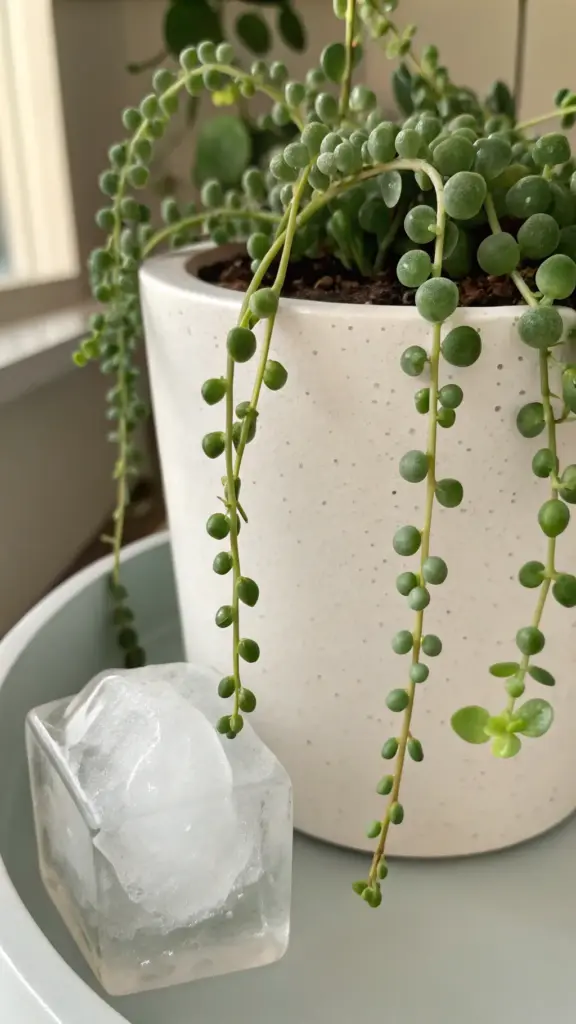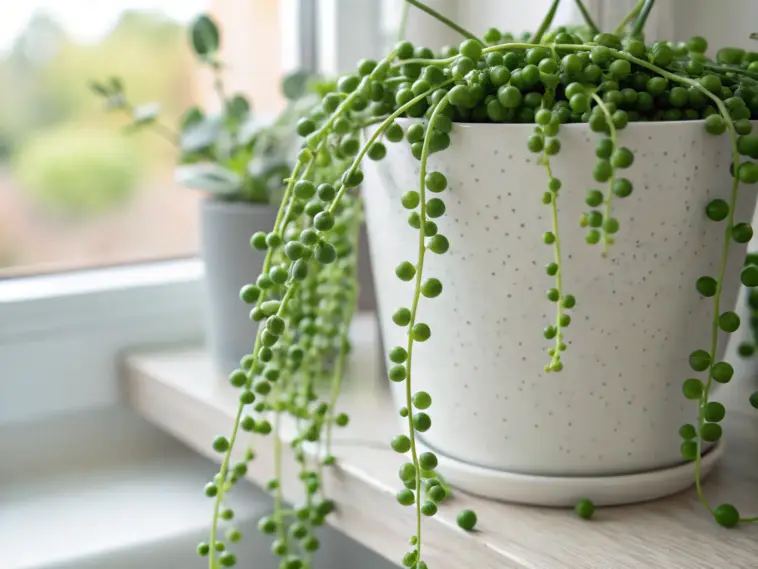Did you know that 73% of houseplant enthusiasts struggle with keeping their String of Pearls thriving beyond the first few months? I’ve been there too!
After killing my fair share of these gorgeous trailing succulents, I discovered some game-changing care secrets that completely transformed my plant parent journey.
These aren’t your typical “water when dry” tips you’ll find on plant tags – these are the advanced hacks that seasoned plant collectors whisper about in gardening forums.
Whether you’re decorating your Chicago apartment or creating an Instagram-worthy plant corner in your LA home, these five expert techniques will help you cultivate the lush, cascading String of Pearls of your dreams!
1. The Ice Cube Watering Method for Perfect Hydration Control

Okay, I’m gonna be totally honest here – I killed three String of Pearls plants before I figured this out. Three beautiful, expensive plants that turned into mushy disasters because I thought I knew better than nature.
The traditional “soak and drain” method that works for most houseplants? Yeah, that’s basically a death sentence for these delicate trailing beauties.
Why Traditional Watering Destroys String of Pearls
Here’s what I learned the hard way: String of Pearls roots are incredibly sensitive to standing water. When you dump a bunch of water on them at once, those tiny root systems just can’t handle it.
I remember my first plant – gorgeous, full, cascading down my bookshelf like a green waterfall. Then I gave it what I thought was a “good drink” and within a week, half the pearls were mushy and falling off.
The problem isn’t just overwatering – it’s the shock of sudden moisture.
Traditional watering creates these intense wet-dry cycles that stress the plant. In their natural habitat, String of Pearls get gentle, consistent moisture from morning dew and light desert rains.
The Ice Cube Game-Changer
This is where the ice cube method completely revolutionized my succulent game. I was skeptical at first – I mean, ice cubes? Really?
But think about it: as the ice melts, it releases water super slowly. We’re talking about a gradual moisture release over 2-3 hours instead of a sudden flood.
This mimics exactly how these plants receive water in nature.
Step-by-Step Ice Cube Technique
Here’s my foolproof method that’s kept my String of Pearls thriving for over two years:
Step 1: Use 2-3 regular-sized ice cubes for a 6-inch pot. Smaller pots get 1-2 cubes, larger ones might need 4-5.
Step 2: Place the cubes directly on the soil surface, about 2 inches away from the main stem. Never put ice directly on the plant itself.
Step 3: Let them melt completely – usually takes 2-4 hours depending on room temperature.
I do this every 10-14 days during growing season (spring and summer). In winter, I stretch it to every 3 weeks because the plant’s basically hibernating.
Perfect Ice Cube Placement Strategy
This part took me forever to figure out! You want to place the cubes near the root zone but not touching the pearls themselves.
I create a little triangle pattern with my ice cubes around the pot’s perimeter. This ensures even water distribution as they melt.
Pro tip: If your String of Pearls is trailing over the pot edges, lift those strands gently before placing your ice cubes. Trust me, wet pearls sitting on ice is not a good look.
Seasonal Climate Adjustments
Living in different climates means adjusting your ice cube game. When I lived in humid Florida, I used smaller cubes and spaced treatments further apart.
Now in drier Colorado, I sometimes add an extra cube during those brutal winter months when the heater’s running constantly.
Summer adjustments: Use ice cubes every 7-10 days when temperatures hit 80°F+. The plant’s actively growing and needs more consistent moisture.
Winter modifications: Stretch to every 2-3 weeks. The plant’s dormant and too much moisture will cause root rot faster than you can say “dead succulent.”
For my friends in Seattle with that constant drizzle – you lucky ducks might only need ice cubes every 2 weeks year-round.
The best part? You’ll actually see your String of Pearls perk up within 24 hours of ice cube watering. Those pearls get plumper and the color becomes more vibrant.
Ready to take your String of Pearls care to the next level? Click the “next” button below to discover the strategic pruning technique that literally doubled the fullness of my plant – and how one simple snip can turn your single strand into a cascading masterpiece!










GIPHY App Key not set. Please check settings